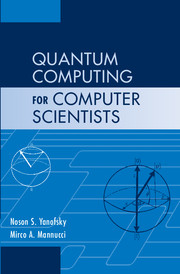Book contents
- Frontmatter
- Contents
- Preface
- Introduction
- 1 Complex Numbers
- 2 Complex Vector Spaces
- 3 The Leap from Classical to Quantum
- 4 Basic Quantum Theory
- 5 Architecture
- 6 Algorithms
- 7 Programming Languages
- 8 Theoretical Computer Science
- 9 Cryptography
- 10 Information Theory
- 11 Hardware
- Appendix A Historical Bibliography of Quantum Computing
- Appendix B Answers to Selected Exercises
- Appendix C Quantum Computing Experiments with MATLAB
- Appendix D Keeping Abreast of Quantum News: Quantum Computing on the Web and in the Literature
- Appendix E Selected Topics for Student Presentations
- Bibliography
- Index
10 - Information Theory
Published online by Cambridge University Press: 05 June 2012
- Frontmatter
- Contents
- Preface
- Introduction
- 1 Complex Numbers
- 2 Complex Vector Spaces
- 3 The Leap from Classical to Quantum
- 4 Basic Quantum Theory
- 5 Architecture
- 6 Algorithms
- 7 Programming Languages
- 8 Theoretical Computer Science
- 9 Cryptography
- 10 Information Theory
- 11 Hardware
- Appendix A Historical Bibliography of Quantum Computing
- Appendix B Answers to Selected Exercises
- Appendix C Quantum Computing Experiments with MATLAB
- Appendix D Keeping Abreast of Quantum News: Quantum Computing on the Web and in the Literature
- Appendix E Selected Topics for Student Presentations
- Bibliography
- Index
Summary
I find that a great part of the information I have was acquired by looking up something and finding something else on the way.
Franklin P. AdamsThe topic of this chapter is quantum information, i.e., information in the quantum world. The material that is presented here lies at the core of a variety of areas within the compass of quantum computation, such as quantum cryptography, described in Chapter 9, and quantum data compression. As quantum information extends and modifies concepts developed in classical information theory, a brief review of the mathematical notion of information is in order.
In Section 10.1, we recall the basics of classical information theory. Section 10.2 generalizes this work to get quantum information theory. Section 10.3 discusses classical and quantum data compression. We conclude with a small section on errorcorrecting codes.
CLASSICAL INFORMATION AND SHANNON ENTROPY
What is information really? In the mid-forties, an American mathematician named Claude Shannon set out to establish a mathematical theory of information on a firm basis. To see this, we use Alice and Bob. Alice and Bob are exchanging messages. Let us say that Alice can only send one of four different messages coded by the letters A, B, C, and D.
- Type
- Chapter
- Information
- Quantum Computing for Computer Scientists , pp. 284 - 304Publisher: Cambridge University PressPrint publication year: 2008



